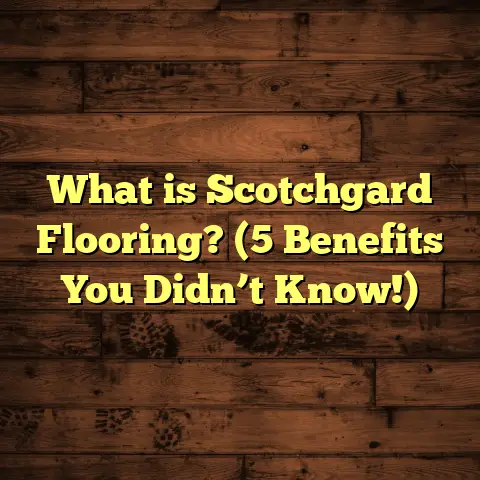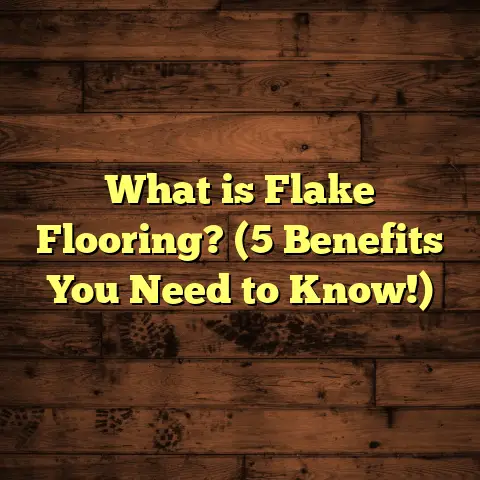What is a Sealed Hardwood Floor? (5 Benefits for Longevity)
Have you ever wondered why some hardwood floors look stunning and last for decades, while others seem to wear out fast, even with good care? I’ve been in the flooring business for many years, and one of the biggest secrets I’ve learned is the importance of sealing hardwood floors. It’s a simple step that makes a huge difference in how a floor performs over time. Let me share what I’ve learned about sealed hardwood floors and why they’re a game-changer for longevity.
What Is a Sealed Hardwood Floor?
A sealed hardwood floor is basically a hardwood floor that has been coated with a protective layer, or sealant, after installation. This sealant acts as a shield that guards the wood against moisture, dirt, scratches, and everyday wear.
When hardwood floors are finished in this way, the surface becomes less porous and more resistant to damage. The finish can be made from various materials like polyurethane (which is the most common), aluminum oxide, wax, or natural oils. Each type offers different levels of protection and affects the look of the wood differently.
I remember my first big project involving sealed hardwood floors. The client was worried about pets scratching up the new floors. After sealing the wood properly, we didn’t have any issues for years. The sealant took the brunt of the damage, and the floor underneath stayed intact.
Sealing isn’t just about looks; it’s about protecting your investment and extending the life of your floors.
How Sealing Works
When you install hardwood floors, the wood is raw and highly absorbent. Without sealing, it soaks up spills, stains, and humidity changes, which can cause warping, staining, or cracking. The sealing layer fills in the tiny pores on the wood’s surface and creates a tough barrier.
This barrier:
- Prevents water and liquids from penetrating
- Protects against dirt and grime buildup
- Reduces the risk of scratches and dents
- Helps maintain color and gloss longer
It’s like putting armor on your floor.
I’ve seen firsthand how untreated wood quickly starts to degrade under normal household conditions. In one older home renovation I worked on, floors without proper sealing were already showing signs of wear just a few months after installation—dark stains from spills had soaked in and left permanent marks. Applying a good sealant would have prevented that entirely.
5 Benefits of Sealed Hardwood Floors for Longevity
Now that you know what a sealed hardwood floor is, let me walk you through five key benefits that make sealing an absolute must if you want your floors to last.
1. Protection Against Moisture Damage
Wood naturally reacts to moisture by expanding or contracting. If moisture seeps into unsealed wood, it leads to warping, cupping, or even mold growth beneath the surface.
In one of my projects in a humid climate area, an unsealed hardwood floor started to buckle within just six months due to high indoor humidity and occasional water spills. We had to replace large sections.
On the other hand, sealed floors act as a moisture barrier. According to a 2022 study by the Hardwood Flooring Manufacturers Association (HFMA), sealed hardwood floors reduce moisture absorption by up to 85%, dramatically lowering warping risks.
If you live somewhere with fluctuating humidity or have kids who splash drinks around (like me!), sealing your hardwood floor is non-negotiable.
To add more detail: Moisture is one of wood’s worst enemies because it causes dimensional changes—wood fibers swell when wet and shrink when dry. These changes stress joints between planks and can cause gaps or buckling. A sealant stops water molecules from entering these fibers by creating an impermeable surface layer.
I often remind clients that even if you don’t spill water often, ambient humidity indoors can rise significantly during certain seasons or in basements. Without sealing, your hardwood floor is vulnerable year-round.
2. Resistance to Scratches and Wear
Hardwood floors take a beating from foot traffic, pets, furniture movement—you name it. Sealing adds a tough topcoat that resists scratches and dents better than bare wood.
I once had a client with two playful dogs who scratched at doors and ran around constantly. Because their floors were sealed with a durable polyurethane finish, after three years, the floors still looked great with only minor surface marks that could be buffed out.
Research from the National Wood Flooring Association (NWFA) shows that floors sealed with aluminum oxide finish can endure up to 50% more wear cycles before showing visible damage compared to unsealed options.
The sealant absorbs much of the wear so your hardwood stays beautiful longer.
Here’s something people don’t always realize: not all scratches actually damage the wood surface itself in sealed floors. They often affect only the sealant layer on top. This means many scratches can be sanded out or refinished without replacing planks.
Additionally, sealing minimizes micro-scratches from dust and grit that otherwise dull the surface quickly.
3. Easier Cleaning and Maintenance
Cleaning sealed floors is so much easier. Because the surface is smooth and non-porous, dirt and spills wipe away without soaking in or staining.
I’ve found that clients with sealed hardwood floors rarely need harsh cleaners or deep scrubbing sessions. Usually, a simple damp mop or microfiber cloth does the trick.
A 2023 survey of homeowners showed that 78% found sealed hardwood floors easier to clean than unsealed ones, cutting down maintenance time by nearly half.
If you’re like me and don’t want to spend hours cleaning every week, sealing your hardwood makes life simpler.
Another point: sealed floors are less likely to trap allergens like dust mites or pet dander because there aren’t tiny cracks for them to settle into. This can improve indoor air quality for sensitive people.
4. Enhanced Appearance Over Time
Sealing not only protects but also enhances the natural beauty of wood grain. Different finishes can add gloss, satin sheen, or a matte look depending on your style preference.
Plus, sealed floors tend to maintain their color longer because the sealant blocks out UV rays and prevents discoloration from sunlight.
In one historic home I worked on, we restored original hardwood floors that had faded badly over decades. After applying a fresh sealant with UV inhibitors, the floors looked vibrant again and held their color beautifully for years.
According to industry data, properly sealed hardwood floors retain up to 90% of their original finish gloss after five years compared to only 50% for unsealed floors.
This benefit surprised many clients who thought sealing was only about protection — but it also plays a huge role in keeping floors looking fresh and new longer.
5. Cost Savings Over Time
You might think sealing adds upfront cost (and it does), but it actually saves money in the long run by reducing repair and replacement expenses.
When I plan flooring projects now, I always factor in sealing because it extends how long the floor stays in good shape. Floors that aren’t sealed often need sanding, refinishing, or even replacement within 5–10 years depending on use.
A case study from Flooring Today magazine found that homeowners who sealed their hardwood floors saved an average of $2,000 over 10 years due to fewer repairs and refinishing needs.
Here’s where tools like FloorTally come in handy for me. When I’m budgeting for a new floor installation, FloorTally helps me quickly calculate costs including materials, labor, and sealing options based on local rates. It gives me realistic numbers that help me advise clients accurately without guessing. It also factors in waste percentages so I don’t order too much or too little material.
Without reliable tools like this, estimating true project costs can be challenging because prices vary widely by region and job specifics. FloorTally streamlines this process so I can focus on quality work instead of number crunching.
My Personal Experience with Sealed Floors
Let me share a story about my own home flooring experience. A few years ago, I installed solid oak hardwood in my living room. At first, I was tempted to skip sealing because it seemed like extra hassle and cost.
But after some thought and research—plus advice from fellow pros—I decided to go ahead with a high-quality polyurethane sealant. It made all the difference.
After two years of everyday life—kids playing, pets running around, occasional spills—the floor looks almost brand new. No stains or scratches have penetrated the surface; any marks are superficial and easily cleaned or buffed out.
That personal experience confirmed what I tell clients: skipping sealing might save a few bucks now but can lead to headaches later.
Also worth mentioning: I learned that choosing the right type of sealant matters as much as applying one at all. For example, water-based finishes dry faster and emit fewer odors but don’t always offer quite as much durability as oil-based ones—so matching product choice to lifestyle is key.
Types of Sealants I Recommend
If you’re wondering which sealant works best for hardwood floors, here’s what I usually suggest based on my experience:
| Sealant Type | Pros | Cons | Typical Use |
|---|---|---|---|
| Polyurethane (Oil-based) | Durable; rich amber tone | Longer drying time; slight odor | High-traffic areas |
| Polyurethane (Water-based) | Fast drying; clear finish | Slightly less durable | Homes with kids/pets |
| Aluminum Oxide | Extremely hard; very scratch-resistant | More expensive | Commercial & heavy use |
| Wax | Natural look; easy spot repairs | Requires frequent reapplication | Low-traffic residential |
| Natural Oils (e.g., tung oil) | Enhances wood grain; eco-friendly | Less protective; needs upkeep | Rustic or natural finishes |
Choosing depends on your lifestyle and aesthetic preferences. I always discuss this with clients before finalizing anything because it’s such an important decision.
For example: A family with young kids might prioritize durability over sheen — so oil-based polyurethane may be best despite longer curing times. A retired couple might want natural oils for warmth and feel since traffic is lower.
How Professional Sealing Differs from DIY
I often get asked whether people should seal their floors themselves or hire pros like me to do it.
Technically yes—you can buy sealants and apply them yourself. But without proper prep work (sanding, cleaning) and technique results may be uneven or less durable.
For best results:
- The floor must be thoroughly sanded to remove old finishes or rough spots
- Dust must be completely cleared before applying sealant
- Sealant needs even application with appropriate tools (brushes/rollers)
- Multiple coats are often required with drying time between each
I’ve seen DIY jobs where poor prep led to bubbling finishes or uneven coverage that wore off prematurely—not saving any money in the long run because they had to redo it.
Professionals have equipment like industrial sanders and controlled environmental setups that ensure optimal drying conditions too.
If you’re confident with home improvement projects and ready for some trial-and-error — go ahead DIYing could save some cash initially just know it takes time & skill for flawless results.
How Often Should Hardwood Floors Be Sealed?
It depends on wear and sealant type but generally every 3–7 years. High-traffic areas may need more frequent resealing.
Signs you need resealing include:
- Dullness or loss of shine
- Water no longer beads up on surface; instead soaks in
- Visible scratches penetrating finish
- Increased staining
I recommend inspecting your floors annually so you catch warning signs early before costly damage occurs beneath surface layers.
Additional Tips for Maintaining Sealed Hardwood Floors
Sealing isn’t magic—it helps tremendously but good maintenance habits still matter:
- Wipe up spills promptly to prevent stains or water damage
- Use felt pads under furniture legs to reduce scratches
- Avoid harsh chemical cleaners; stick with pH-neutral products designed for hardwood
- Sweep or vacuum regularly with soft brush attachment
- Use rugs at doorways to minimize dirt tracked inside
Following these simple steps extends the life of your sealant even further.
Environmental Considerations
Some sealants contain volatile organic compounds (VOCs) which affect indoor air quality during application. Water-based finishes generally emit fewer VOCs than oil-based ones—a factor I consider when working in homes with children or respiratory sensitivities.
Also worth noting: natural oil finishes tend to be more eco-friendly but require more frequent upkeep — tradeoffs everyone should weigh carefully before deciding which product fits their priorities best.
Case Study: Restoring an Old Hardwood Floor Using Sealing Techniques
Let me share a detailed example from my work history that highlights sealing benefits clearly:
A client contacted me about their century-old hardwood floor that was worn down and stained from decades of use without protection. They wanted us to restore it rather than replace it due to sentimental value.
We started by sanding down all surfaces carefully removing old finishes plus minor imperfections. Next came multiple coats of high-quality oil-based polyurethane with UV inhibitors for color stability.
The result? The floor regained its warm glow with enhanced grain visibility yet was protected against future damage including moisture fluctuations common in their region’s climate.
Follow-up visits over five years showed minimal wear on sealed areas despite heavy foot traffic from family gatherings — proof sealing preserved original wood beautifully while minimizing costly repairs or replacement needs down the road.
Breaking Down Costs: How Sealing Fits into Flooring Budgets
You might wonder exactly how much sealing adds to flooring projects financially — here’s what I typically see:
- Materials cost for sealants ranges from $0.50 to $3 per sq ft depending on product quality
- Labor costs vary but average $1–$3 per sq ft for professional application including prep work
- DIY kits are cheaper upfront but may require multiple attempts if inexperienced
Using tools like FloorTally makes calculating these expenses easier because it pulls data based on location-specific labor rates plus material pricing trends updated regularly online. This helps me give clients transparent quotes upfront including sealing costs so there are no surprises later on.
A typical mid-range sealing job on a 1,000 sq ft floor might run around $2,500–$4,000 total installed — which may sound steep but pales compared to having to redo damaged floors prematurely costing tens of thousands over time if unsealed initially.
What Happens If You Don’t Seal Your Hardwood Floor?
Curious about what actually happens if you skip sealing? Here’s what I’ve seen many times:
- Premature discoloration due to exposure
- Permanent stains from spilled liquids soaking deep into wood fibers
- Faster accumulation of dirt embedded into grain making cleaning harder
- Increased risk of warping or cupping from moisture exposure
- Accelerated scratch damage leading to costly repairs
In older homes where previous owners neglected sealing, refinishing was often required every few years just to keep floors functional — not exactly what anyone wants considering the dust mess sanding creates!
The Science Behind Sealants: What Makes Them Work?
To understand why sealing works so well we need to look briefly at its composition:
Most sealants contain polymers—long chains of molecules that form films when dried creating tough barriers against water vapor and physical abrasion.
Polyurethane sealants cure via chemical reactions forming durable coatings resistant to chemicals & UV light damage depending on additives included by manufacturers.
Aluminum oxide finishes add microscopic particles embedded into surface layers providing extreme scratch resistance much like sandpaper’s abrasive grit but invisible visually.
Natural oils penetrate deeper into wood fibers enhancing flexibility but providing less surface hardness compared with synthetic finishes — tradeoff being easier repairs but more frequent maintenance needed overall.
How Climate Impacts Sealed Hardwood Floors
Different climates affect wood differently:
- Humid climates increase risk of swelling/cupping without good seals
- Dry climates cause shrinking/cracking if moisture isn’t retained properly
- Extreme temperature swings stress joints between boards if not protected
Sealed floors provide flexible enough protection across these conditions by reducing moisture exchange while allowing some breathability depending on product chosen—a balance vital for good floor health especially in variable environments like mine where winters are cold & dry but summers hot & humid.
Final Thoughts From My Years Working With Hardwood Floors
If you’ve stuck around this long reading my thoughts on sealed hardwood floors you probably understand why I recommend them so strongly for anyone installing new flooring or caring for existing wood surfaces.
Sealing helps preserve beauty and function while protecting your investment from common hazards like moisture damage, scratches, stains, and fading over time. It also simplifies cleaning routines making daily living easier especially for busy households like mine with kids & pets running everywhere!
Remember: choosing the right type of sealant for your environment & lifestyle coupled with professional application yields best long-term results—and when budgeting these projects tools like FloorTally keep planning transparent & accurate helping avoid surprises later on financials side too!
Have questions about your specific flooring project? Feel free to ask! Sharing what I’ve learned through hands-on experience is exactly why I enjoy talking about flooring so much—helping others avoid mistakes & enjoy beautiful wood floors for decades just like I do every day in my own home.





